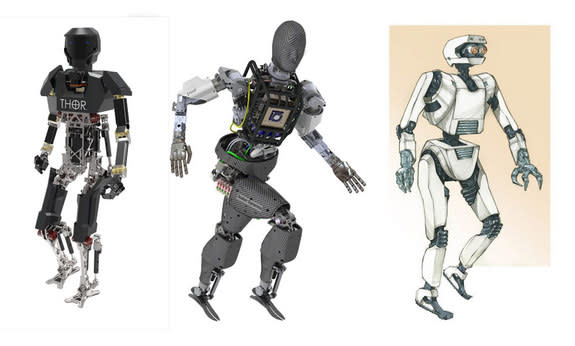Robots Assemble for Military's $2 Million Challenge

A headless humanoid robot clambers noisily through an obstacle course with the grim, unfeeling purpose of a terminator. Luckily, it's just the latest video celebrating the official start of a U.S. military challenge to create robots that can work alongside humans in disaster scenarios.
Seven robot designs star in the early lineup chosen by U.S. Defense Advanced Research Projects Agency for its $2 million DARPA Robotics Challenge (DRC), according to an agency announcement on Oct. 24. They include a two-legged descendant of NASA's Robonaut that is currently assisting astronauts aboard the International Space Station, a new Guardian humanoid robot based on Raytheon's military exoskeleton suits, and a small Korean Hubo robot that has featured in many YouTube videos.
"Just as natural and man-made disasters are common worldwide challenges, what the response to the DRC has shown is that the international robotics community shares a common goal of advancing robotic technology to the point where it can have a tangible and positive impact on humanitarian assistance and disaster relief," said Gill Pratt, DARPA program manager for the competition.
The Pentagon's DARPA wants robots that are able to eventually do many things humans can — such as opening a door by using the handle, climbing a ladder or even wielding power tools to break through walls. Such robots must also have the capability to handle steering, accelerating and braking from the driver's seat of a vehicle.
The seven teams chosen for "Track A" of the competition have agreed to create their own robot hardware and software to be eligible for DARPA contracts worth $3 million. They include Carnegie Mellon University's National Robotics Engineering Center, Drexel University, Raytheon, SCHAFT Inc., Virginia Tech, NASA's Johnson Space Center and NASA's Jet Propulsion Laboratory. [6 Tips for Inventors From a DARPA Program Manager]
DARPA has also chosen "Track B" companies that will make only make robotic software for testing in a robot of DARPA's choosing. Those teams are eligible for DARPA contracts worth $375,000, and will eventually test their software in a standard DARPA robot similar to the humanoid Pet-Proto robot made by Boston Dynamics.
The B teams include Lockheed Martin's Advanced Technology Laboratories, RE2, University of Kansas, Carnegie Mellon University, Massachusetts Institute of Technology, TRAC Labs, University of Washington, Florida Institute for Human and Machine Cognition, Ben-Gurion University, NASA's Jet Propulsion Laboratory and TORC Robotics.
Other robotics teams can still compete for "Track C" (software only) or "Track D" (hardware and software), but those groups won't receive DARPA funding.
DARPA has already made a beta version of a robot simulation program available, so that teams can test their robot designs in the relatively inexpensive safety of virtual reality. The U.S. military agency enlisted the Open Source Robotics Foundation to help improve the simulator.
Despite the emphasis on humanoid robots, DARPA took care to mention that robots don't need to be humanoid to compete. One example is the ape-inspired RoboSimian from NASA's Jet Propulsion Laboratory that mostly walks about on all four limbs.
The competition is scheduled to continue through 2014. But whichever robot comes out on top, there's a good chance that at least one will be forced by its human overseers to dance to the viral tune of "Gangnam Style" — even if DARPA has no such requirement in its contest.
This story was provided by TechNewsDaily, a sister site to LiveScience. You can follow TechNewsDaily on Twitter @TechNewsDaily, or on Facebook.
Copyright 2012 LiveScience, a TechMediaNetwork company. All rights reserved. This material may not be published, broadcast, rewritten or redistributed.

